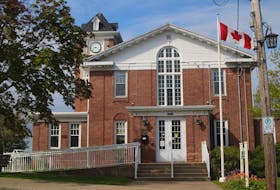AMHERST, N.S. — In mid-1916, in the midst of the First World War, internees at an Amherst prisoner of war camp began publishing a newspaper about their lives in detention, thousands of miles from the horrors of the trenches of the Western Front.
More than a century later those papers, named the Amherst Spatz (or Sparrow) have been unearthed in the German archives and copies sent to Cumberland-Colchester MP Bill Casey, who organized a celebration in July commemorating the 100th anniversary of the closure of the Amherst camp in September 1919.
It’s believed the paper was only published until January 1917 and only 14 editions were created, but their words are a snapshot of life in an internee imprisoned in Amherst.
“These newspapers open a window for us on life in the German POW camp in Amherst a century ago,” Casey said Wednesday while looking through copies of the papers provided by the German embassy in Ottawa. “It’s in their own words.”
During planning for the commemoration ceremony two months ago, Casey was notified by the embassy that copies of the internees’ newspaper had been found in the German archives in Berlin.
“When we first started talking to the German embassy about the possibility of hosting an event, they knew nothing about the camp’s presence in Amherst. The first thing they did was to go back through their archives in Berlin to see if there were any records of the camp in existence,” Casey said. “What they found were these perfect copies of the newspapers that the prisoners made. “To me it’s the most complete record of what it was like to life in a German POW camp in Canada during the First World War.”
Casey received copies of the originals recently and he has been going through them with the help of retired Amherst lawyer Morris Haugg, who moved to Canada from Bavaria in 1960.
“What I have done so far is glance through many of the pages to glean some idea as to what the approach of the authors was, what they were trying to accomplish and why it started in the first place. It was obviously meant as a morale booster for the prisoners,” Haugg said.
From what he has learned to date, most of the writing, that had to be approved by a censor, was done by two authors with two helpers, who did the graphics and layout – including drawings of living conditions, the sleeping quarters and the dining room.
He noted a lot of stoicism in the papers and the need for the inmates to not give up. He also found a sense of humour among the authors who wrote they got an old used typewriter and a copying machine and were trying to create something as long as their brains would last.
Haugg said the editions he has read describe regular life in the camp and the “characters” living there, the desire to go home, or to go back to fight for the Fatherland.
There’s poetry and short stories written by several of the internees as well as advertisements for upcoming events, including concerts by the camp band and a celebration to mark the birthday of Kaiser Wilheim in January 1917 that included speeches, musical performances, operettas, marches and gymnastics demonstrations.
There is also reference to an exhibition at a local school where the internees were able to show off and sell what they made at the camp. It’s in one of the newspapers where the creator of a model wooden ship of the Kaiser Wilhelm der Grosse, the ship from which most of the internees came from, was identified as g. wackerbart.
The ship that has been in the Casey family’s position for decades was restored by Matthew Casey and displayed during the commemoration ceremony in July. The MP is hoping to work with the German government to identify and contact the creator’s descendants to let them know something their ancestor created at an internment camp in Amherst more than a century ago still exists.
The papers have also helped solve a few mysteries about the camp. It was unknown where the internees secured tools and building materials to construct the items they sold in the community and how they were able to sell them.
Haugg said the newspapers reveal that the YMCA was instrumental in helping provide materials while the internees were taken to a “local school” to show and sell their creations to the public.
Haugg said there are several issues missing and some of the issues have missing pages. He doesn't know if there are additional issues in the archives because there’s no indication whether the January 1917 paper was the last one. He said there could be more considering the war didn’t end until November 1918 and the camp wasn’t dissolved until almost a year after that.
Casey is hoping to have all the newspapers translated so they can be displayed at the Cumberland County Museum, which has a permanent exhibit on the internment camp. He’s also hoping to publish all the articles.
Haugg said the newspapers will continue to tell stories for years.








